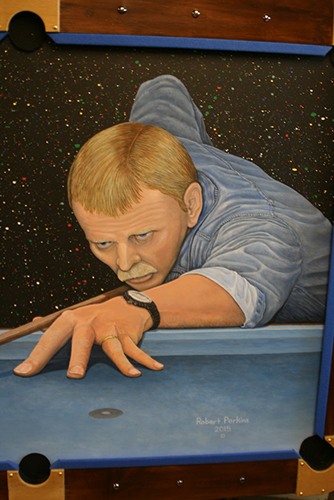
10 Flint Avenue, P.O. Box 398, Bancroft, Ontario K0L 1C0 Phone 613-332-1542 email: artgalleryofbancroft@gmail.ca
Proudly supported by:

Opening reception:
Friday, December 9 | 7:30 pm

The exhibition is in part of retrospective of his art practice stretching back over 30 years. The recent three dimensional painting, In the Zone, depicts an older Perkins watching a younger Perkins playing pool. An accomplished pool player, Perkins sees the painting as bittersweet. He cannot play pool as well as he used to because he had what he called a “heart explosion, not a heart attack” last year. He was dead for thirty minutes and on life support for two days before he came back. Perkins believes that the title of the show, Transitions, works on many levels – from the changes he has seen in his art practice since he moved here from Chicago and the way he approaches his work since he “died”.
In looking back, Perkins says he can understand how creating is important to him and says “creating gives his life value”.
Robert Perkins spent his early years growing up in the city of Chicago, but developed a deep love for the quiet and solitude of the country. Not long after graduating in 1971 from Southern Illinois University with a degree in Arts & Education, he moved to Ontario Canada.
When he settled in Bancroft he devoted himself to interpreting his new rural location through his drawings and paintings. This would prove quite a change from the painting he did in the USA where his instructors and the times were pushing for creating more abstract work. In Bancroft, he started to focus on painting wildlife and nature – “I liked it and it was what people wanted to buy and it helped pay the rent.” Many people who lived in Bancroft in the late 70s and early 80s, may remember seeing Perkins outside drawing the buildings and landscapes of the area. He said he was considered the unofficial Bancroft Resident Artist by some because he was drawing the area’s places and buildings – some that have burnt down and no longer here.
In 1984 Mr. Perkins was offered the position of arts instructor at the Madawaska Valley District High School in Barry’s Bay. He redesigned the arts program and in 1986 he was given the headship of the Arts Department at the high school. In 1997 Perkins was awarded the Prime Minister’s Award for Teaching Excellence in 1997. The Awards have honoured exceptional elementary and secondary school teachers in all disciplines since 1993, with over 1,500 teachers honoured to date. Perkins was the first art teacher to receive the award.
Perkins loved teaching. “I had wonderful students and when I was helping them develop their ideas, I was able to develop my own. I remember leafing through a magazine while the students were working on their projects in the class and saw an science fiction image of people walking with fish floating beside them.” That was the beginnings of what became his fantasy fish sculptures. Some examples of his fantasy fish will be part of this exhibition.
I have also developed a love for ceramic sculpture and have found that my “Fantasy Fish” creations, which evolved out of my work as head of the Madawaska Valley District High School Art Department… served as a form of creative balance and rest in between the development of my paintings.”
In 2008, Mr. Perkins retired and focused his time on his own art practice.
In Bob’s words: “I effectively began my artistic career with my arrival to Canada and Bancroft, from Chicago, in 1973. In “Transitions” I feel my work has come full circle. My creative style has evolved from a more abstractionist style in my early years, through a greater embrace of the Canadian environment that had now become my home… and ultimately the depiction of those individuals who have been closest to me.
Mr. Perkins’ paintings, sculptures and drawings has been well received in numerous group and solo exhibitions. His work is also in private collections in North America, Europe and Asia.

10 Flint Avenue, P.O. Box 398, Bancroft, Ontario K0L 1C0 Phone 613-332-1542 email: artgalleryofbancroft@gmail.ca
Proudly supported by:

Charitable Registration #: 81973 7750 RR0001
The Art Gallery of Bancroft is situated on the traditional territory of the Anishinaabeg Algonquins, which is known to be unceded. Indigenous people have been stewards of this land since time immemorial; as such we honour and respect their connection to the land, its plants, animals and stories. Our recognition of the contributions and historic importance of Indigenous peoples is sincerely aligned to our collective commitment to make the promise and the challenge of truth and reconciliation real in our community.